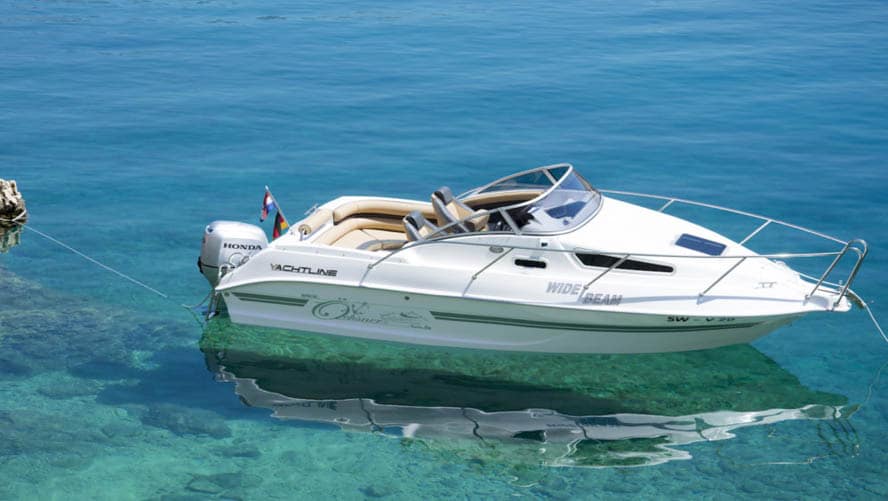A trailerable boat offers freedom and independence. Today on the Rhine and tomorrow maybe in Croatia: a trailerable boat can be theoretically slipped or craned wherever you want and is not limited to the waterways or coastal sections near the mooring.
But what do you have to consider if you want to trailer a boat? Which dimensions, weights and other requirements must be met? Here are a variety of terms and numbers that often confuse more than they help.
Whether you can trail a boat depends not only on the boat. It is a combination of several factors that basically affect the following points:
- Boat
- Towing vehicle
- Trailer
- Driver's license
As a specialized manufacturer of trailerable boats and trailers we know the questions of our customers. And we are happy to provide the answers.

The current largest trailable boat - the SRX30 -Yachtline- (customer's photo)
Specifications and requirements for trailable boats and towing vehicles
Dimensions and weights: which limits has the trailerability?
In Europe, these limits apply in principle:
- 3.5t towing capacity (boat incl. trailer)
- 2.55m width
- 12m length / 18m trailer length
Exceptions are in the UK, Luxembourg, Macedonia, Montenegro and Serbia (changes reserved).

Our 20 -Yachtline- while slipping (customer's photo)
Which car to pull the trailer?
Boat trailer - which driver's license?
In order to be allowed to tow a boat trailer with up to 3.5t towing capacity, at least the following (German) license classes are required:
- the old driving license class 3
- the new driving license class BE
The maximum towing capacity theoretically corresponds to the weight of the car. A trailer incl. Boat may only weigh more than the car if by definition it is an off-road vehicle. Then the maximum weight is 1.5 times the towing vehicle.
This rule is limited by the weight which the towing vehicle is allowed to pull according to the vehicle registration certificate, the already mentioned magic limit of 3.5t and of course the presence of a trailer hitch with corresponding vertical load.
The larger and heavier the boat should be, the bigger and more robust the car must be. Depending on the size of the boat, z. B. a larger station wagon, SUV or off-road vehicle necessary.
Our trailerable boats

SX20 -YACHTLINE-
- Length 5.95 m
- Weight incl. Engine and trailer from 1,500 kg

SR25 -YACHTLINE-
- Length 8.04 m
- Weight incl. Engine and trailer from 2.500 kg

29-YACHTLINE-
- Length 9.05 m
- Weight incl. Engine and trailer from 3.350-3.500 kg

SRX30 -YACHTLINE-
- Length 10.23 m
- Weight incl. Engine and trailer from 3.400-3.500 kg
Trailer for boats
There are both steel and aluminum boat trailer. According to experience, the weight savings in aluminum ones is around 100kg. The closer a boat is to the weight limit, the more meaningful an aluminum trailer can be to increase the possible payload. Therefore, we offer eg. to our largest trailerable boat, the SRX30 -Yachtline-, also the aluminum version.
In addition to the equipment, the payload and the vertical load are particularly important in the trailer.
What is the payload of the trailer?
The payload is the weight with which you can load the trailer. In our case, it's the boat weight.

What is the vertical load of the trailer?
The vertical load is the weight that rests on the trailer hitch. By adjusting the position of the boat on the trailer, the charge concentration and thus the vertical load can be changed.
The permissible vertical load can be found in the vehicle registration document of the towing vehicle. However, it improves the handling when the vertical load is used as possible.
Which equipment does a boat trailer need?
Due to the weight of motorboats, braked boats trailers are qualified, which are equipped with different lights and reflectors.
For a better storage or slipping in and out of the boat, there are still additional features that you should not do without a boat trailer:
- Vertical load
For free movement of the trailer when coupling and uncoupling - Bow support
End stop of the boat for an always same position on the trailer - Keel and bow end stop
To secure the boat - Keel rollers
The boat rolls over or off the trailer - Lengthwise bearing surfaces
To secure and stabilize the boat
- Shock absorber
To improve the handling and the protection of the material (at 100 km/h approval shock absorbers are a duty in Germany). - Winch
Wire rope or belt - Adjustable light bar
For easy adjustment respectively attach and dismantle - Chocks
To secure the trailer against rolling away







